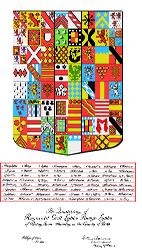

Does the College accidentally hinder scholarship?The problem revealed by the previous pages is threefold. First that there seems to have been a change in the manner of inheriting quarterings, perhaps within the first two hun dred years of heraldry. Second that a slightly defective achievement was produced around 1927, the principal problems being genealogical. Third that seventy years later a genealogical chart was produced encapsulating all the original problems and revealing several more. I have nothing more to say on the first issue, but the mainly genealogical errors are worth further consideration. Am I right that errors have been made? Have my methods of research been adequate? I must admit that I am not a medieval scholar: I cannot read let alone translate any documents of that period. The principle of good genealogy is to obtain documents that survive from the times of the people concerned, so I cannot begin to follow this. What I have done is to search out books and articles by people who are scholars and who have got to such documents. For the core assertions that six arms were not quarterable I have relied on three sets of books: first, Complete Peerage, second edition, second Victoria County History (specifically Oxford, vol 12, pp. 274-281) and third "The Barrington Family History" by William Clayton, with a transcription on this site. Each of these works is based on surviving documents of those times and is, in my opinion, done by competent scholars. The question then is what has been the College's methodology that did not lead them to the same conclusions as mine? With some temerity, I suggest that their standard method is to refer to pedigrees and heraldic records in their possession, many of which descend from the times of the Visitations. The problem with the Visitations is that they were the result of Royal Commissions so their records could be produced in a court of law and would be accepted without further question. The Visitations, then, were and maybe still are a disincentive to scholarship. It is a remarkable feature of many fields of enquiry, particularly in the antiques trade, that the primary search for evidence is to obtain the opinion of the currently regarded expert in that field; even, this is at the core of my methods. What more can a simple enquirer do than consult that expert and quote their opinion to their clients? It is not thought to be the job of the simple enquirer to make their own enquiries, theirs is not to question why but to do or die. It would seem that a similar spirit has percolated the College. Of course the obvious reason for this spirit is cost, the College's fees are already beyond the reach of the man in the street, adequate scholarship would take them into the stratosphere. It is a sensible way to conduct a business, to keep the processes simple and adequate to the task in hand. A further problem with the College's core records is that they are not open to the public. Any other document collection is open to view, if only by competent scholars in a carefully controlled physical environment that will preserve documents already centuries old. The College does not allow this and it seems that scholars cannot examine, contrast and compare their documents with other documents about the same people. So we see no scholarly articles in independent journals that assess the value of the College's genealogical documents. I would therefore endorse all appeals that the College's documents be opened to independent appraisal. I would definitely support any appeal for funds to enable this.
|